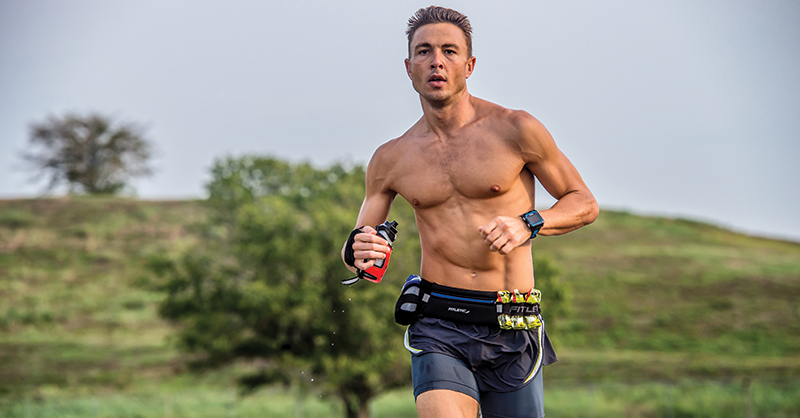Your Cart is Empty
Why is A Runner’s Water Belt Considered Essential for Marathons?
January 23, 2018 3 min read

All first-time marathon runners inevitably panic about how much fluid they need to consume during the marathon. Dehydration happens when you lose more fluid than you drink, as your body can’t work properly if it doesn’t get enough water. When your body is dehydrated, and can’t cool itself down adequately, heat illnesses (heat cramps, heat exhaustion, heatstroke) can occur. Untreated heatstroke can even lead to death!
According to Runner’s World Magazine,
Water stations in a marathon are often located every 5 kilometers or every 2 miles, so there are usually about 8 to 12 stops. Stopping at these aid stations to drink – particularly if they are crowded – can slow you down by a good few minutes. There is also the risk that just when you need an urgent sip, the water station isn’t there or is closed.
A runner’s water belt with provisions for one or two 6 oz or 8 oz running belt water bottles will give you peace of mind that you have enough fluid on hand for the full duration of the 26.219 miles. A runner's hydration belt can also provide the storage you need for other essential items during your marathon.
The decision about what type of hydration to fill your bottles with in your bottles depends on your objectives. You can either focus on re-hydration (cooling down the body and preserving fluid balance) or the refilling energy (stocking up on sugars and electrolytes).
A lot of sports drinks have high sugar concentration which means that they can’t be quickly absorbed into your bloodstream. They do a poor job of hydrating your body and keeping you cool in hot situations. Some marathon pros recommend only drinking a heavily diluted sports drink or water combined with electrolyte tablets.
Energy gels can help rebuild carbohydrates that get depleted when you run. However, they tend not to have the most appetizing texture. It always helps to drink water in between sips of an energy gel to help absorb it. Also, try to find flavors or textures you prefer before starting a big race. Water is definitely vital, but it's certainly not all you need to stay strong during a marathon. A runner's water belt has easy storage and access for your energy gels so you can keep running while you refuel along the course.
Running your first marathon is like your first day at school. Be prepared for all eventualities and minor injuries. Band-aid, gauze, and jelly-based protection gels are a must-have in any marathon runner’s water belt. Sun blocks come in handy for both the prevention of sun and wind-burn. If you need an inhaler, don’t forget to pack that in your running belt.
All things considered, a well-designed runner’s water belt is as essential to running a marathon as a well-designed pair of running
According to Runner’s World Magazine, How much you need to drink during the marathon to minimize dehydration depends on 4 factors:
- Your body size
- Your running pace
- The heat and humidity
- Your sweat rate
"The maximum amount you should drink during running is the amount that can empty from your stomach or the amount that you've lost as sweat, whichever is less.”If you drink more than you've lost, you face "the risk of hypothermia" (your body's water levels rise, and your cells begin to swell).
Water stations in a marathon are often located every 5 kilometers or every 2 miles, so there are usually about 8 to 12 stops. Stopping at these aid stations to drink – particularly if they are crowded – can slow you down by a good few minutes. There is also the risk that just when you need an urgent sip, the water station isn’t there or is closed.
A runner’s water belt with provisions for one or two 6 oz or 8 oz running belt water bottles will give you peace of mind that you have enough fluid on hand for the full duration of the 26.219 miles. A runner's hydration belt can also provide the storage you need for other essential items during your marathon.
What should I carry in my runner’s water belt?
Sports drinks vs. water
The decision about what type of hydration to fill your bottles with in your bottles depends on your objectives. You can either focus on re-hydration (cooling down the body and preserving fluid balance) or the refilling energy (stocking up on sugars and electrolytes).
A lot of sports drinks have high sugar concentration which means that they can’t be quickly absorbed into your bloodstream. They do a poor job of hydrating your body and keeping you cool in hot situations. Some marathon pros recommend only drinking a heavily diluted sports drink or water combined with electrolyte tablets.
Energy gels
Energy gels can help rebuild carbohydrates that get depleted when you run. However, they tend not to have the most appetizing texture. It always helps to drink water in between sips of an energy gel to help absorb it. Also, try to find flavors or textures you prefer before starting a big race. Water is definitely vital, but it's certainly not all you need to stay strong during a marathon. A runner's water belt has easy storage and access for your energy gels so you can keep running while you refuel along the course.
Emergency kit
Running your first marathon is like your first day at school. Be prepared for all eventualities and minor injuries. Band-aid, gauze, and jelly-based protection gels are a must-have in any marathon runner’s water belt. Sun blocks come in handy for both the prevention of sun and wind-burn. If you need an inhaler, don’t forget to pack that in your running belt.
All things considered, a well-designed runner’s water belt is as essential to running a marathon as a well-designed pair of running







